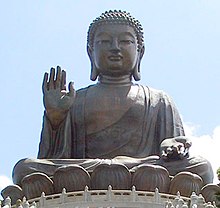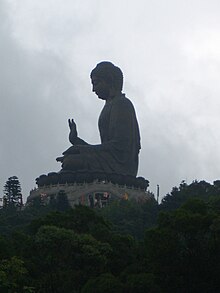The Big Buddha (Hong Kong)



Tian Tan Buddha (Chinese: 天壇大佛) is a large bronze statue of the Buddha, completed in 1993, and located at Ngong Ping, Lantau Island, in Hong Kong. Also known as the Big Buddha, as it is the world's tallest outdoor seated bronze Buddha. The statue is located near Po Lin Monastery and symbolizes the harmonious relationship between man and nature, people and religion. It is a major center of Buddhism in Hong Kong, and is also a popular tourist attraction.
Description
The statue is named Tian Tan Buddha because its base is a model of the Altar of Heaven or Earthly Mount of Tian Tan, the Temple of Heaven in Beijing. It is one of the five large Buddha statues in China. The Buddha statue sits peacefully on a lotus throne on top of a three-platform altar. It is surrounded by eight smaller bronze statues representing gods or immortals.
The Buddha is 34 meters high, weighs 250 tonnes, and was the world's tallest outdoor bronze seated Buddha prior to 2007.[1] It can even be seen as far away as Macau on a clear day. Visitors have to climb 268 steps in order to reach the Buddha, though the site also features a small winding road to the Buddha for vehicles to accommodate the physically challenged.
The Tian Tan Buddha appears serene and dignified. His right hand is raised, representing the removal of affliction. His left hand rests on his lap in a gesture of giving (dhana). The Buddha faces north which is unique among the great Buddha statues. (All others face South.)
In addition there are 3 floors at the bottom of Buddha: The Hall of Universe, The Hall of Benevolent Merit and The Hall of Remembrance. One of the most renowned features inside is a relic of Sakyamuni, consisting of some of his alleged cremated remains. There is a huge carved bell inscribed with images of Buddhas in the show room. It was designed to ring every seven minutes, 108 times a day, symbolizing the release of 108 kinds of human vexations.
History
The Tian Tan Buddha was constructed beginning in 1990, and was finished on December 29, 1993, the birthday of Sakyamuni. The construction costs of the giant Buddha were estimated to be up to $68 million. It was formed out of 202 separate pieces of bronze. In addition to the exterior components, there is a strong steel framework inside the statue to support the heavy load and wind pressure.
When the statue was completed, monks from around the world were invited to the opening ceremony. Distinguished visitors from mainland China, Hong Kong, Taiwan, Japan, Thailand, Korea, Malaysia, Singapore, Sri Lanka, and the United States all took part in the proceedings.
On October 18, 1999 the Hong Kong Post Office issued a stamp depicting the Tian Tan Buddha. The MTR corporation has also issued a tourist souvenir ticket featuring a photograph of the statue.
Visiting and access

Po Lin Monastery and the Buddha are open to the public between 10:00 and 17:45. Access to the Buddha is free of charge. An entrance fee of HK$ 60 is charged for access to the exhibition halls below the Buddha and includes a vegetarian meal (HK$ 100 for the deluxe dinner) served on the monastery grounds (from 11:30 to 17:00). The admission fee includes a souvenir card featuring an image of the Buddha.
Located around the site are various shops selling Buddha-related souvenirs such as statues, incense, and necklaces.
Visitors may also see the nearby monastery, known as the "Buddhist Kingdom in the South," which serves as an international Buddhist retreat, and is one of the largest and most well known in Hong Kong. The monastery was built by three Zen masters in 1920. The main temples have painted vermilion interiors with dragons and many other different Chinese mythical figures on the walls and ceilings. Visitors often spend time in the attached tea garden, the only tea garden in the territory. A five minute walk past the tea garden takes you to the "Wisdom Path" - a very large wooden inscription of the Heart Sutra set within a figure 8 to symbolize infinity. There is a great scenic view of the Tian Tan Buddha if you climb all the way to the top of the hill.

One of the main attractions of this Buddha statue is climbing 268 steps and circling the platform (the lotus) where the Buddha sits. See Video of the climb up the steps to Tian Tan Buddha.
Also nearby is Lantau Peak, the second highest mountain in Hong Kong, a path up and along which also offers a great view of the Buddha and the monastery.
Public transport
Visitors can reach the site by bus or taxi, travelling first to Mui Wo (also known as "Silvermine Bay") via ferry from the Outlying Islands piers in Central (pier No. 6), or to Tung Chung station via the MTR. Visitors may then travel to and from and Buddha via the following bus routes:
- Mui Wo ↔ Ngong Ping — NLB No. 2
- Tung Chung ↔ Ngong Ping — NLB No. 23
A gondola lift, the Ngong Ping Skyrail between Tung Chung and Ngong Ping, provides another means of access.
Comparisons
Summary facts about other great Buddha statues are listed below.
Leshan Giant Buddha (樂山大佛)
|
Lingshan Buddha (靈山大佛) |
| Yungang Buddha (雲崗大佛) | Longmen Buddha (龍門大佛) |
Great Buddha of Kamakura
|
Great Buddha of Nara |
See also
References
- ^ Tan, Bee Hong (5 November 2006). "Watched by the Buddha". Sunday People. The Straits Times Press (Malaysia) Berhad. Retrieved 2006-12-30.
Constructed from 202 bronze pieces, the statue weighs over 250 tonnes and used to be the world's tallest outdoor seated bronze Buddha statue,
{{cite web}}: Check date values in:|date=(help); Cite has empty unknown parameter:|coauthors=(help)
